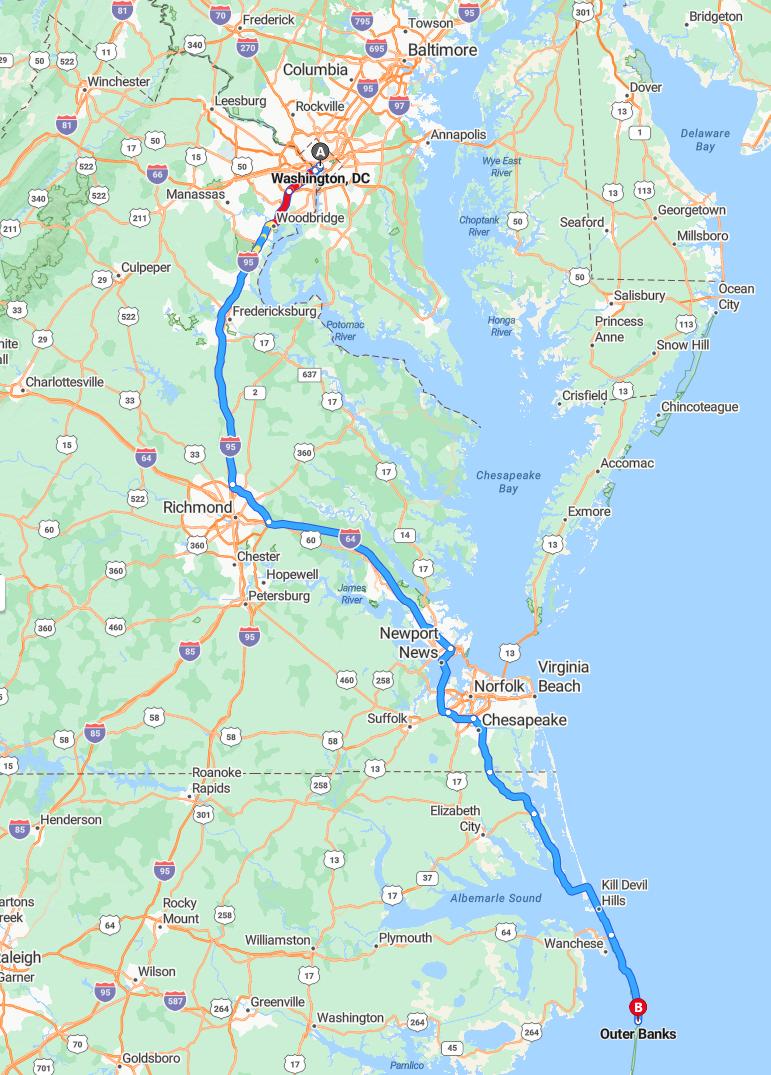Distance and estimated driving time
The drive from Washington to the Outer Banks covers approximately 308 miles and takes around 5 hours and 39 minutes, providing a scenic route along the East Coast. Travelers will primarily navigate via I-95 South and I-64 East, ensuring a smooth and efficient journey. The trip offers a convenient escape from city life to the tranquil beaches of the Outer Banks. Planning ahead for possible traffic or stops can help optimize the travel experience and enjoy the scenic coastal vistas.
Driving route
Embarking on a scenic drive from Washington, DC, to the Outer Banks offers a diverse travel experience through Virginia's vibrant cities and coastal landscapes. Starting in Washington, DC, travelers can appreciate the historic and political significance of the nation's capital before heading south to Fredericksburg, known for its Civil War history. Continuing eastward, Richmond provides a blend of cultural attractions and innovative cuisine, while Norfolk offers accessible waterfront views and naval history. As the journey progresses, Virginia Beach delivers lively beaches and boardwalks, setting the stage for the final destination, the Outer Banks, renowned for its serene beaches, maritime heritage, and natural beauty. This route combines urban exploration with relaxing seaside scenery, making it an ideal coastal road trip.

Best time to start for optimal driving conditions
For the smoothest drive from Washington to the Outer Banks, it's best to start early in the morning, preferably around sunrise, to avoid heavy traffic and midday congestion. Beginning your journey before rush hour reduces exposure to dense city traffic in Washington, DC, and along major route points like Fredericksburg and Richmond. Traveling during weekdays, especially Tuesday through Thursday, typically offers lighter traffic compared to weekends or Mondays, which often see increased travel. Additionally, checking weather forecasts beforehand ensures you can avoid adverse conditions such as storms or heavy rain that can slow down your trip and compromise safety.
Key landmarks and attractions along the route
Traveling from Washington, DC to the Outer Banks offers a scenic journey filled with notable landmarks and attractions. In Fredericksburg, visitors can explore Civil War history at the Fredericksburg and Spotsylvania National Military Park. Continuing south, Richmond boasts the historic James River Park System and the renowned Virginia State Capitol designed by Thomas Jefferson. As you approach the coast, Norfolk's Nauticus maritime center and USS Wisconsin submarine offer engaging experiences, culminating in Virginia Beach's vibrant boardwalk and lively beaches before reaching the picturesque Outer Banks.
Recommended rest stops and gas stations
When driving from Washington to the Outer Banks, it's advisable to plan rest stops at key locations such as Fredericksburg and Richmond, where numerous gas stations and rest areas are available for quick refreshments and relaxation. In Virginia, Norfolk and Virginia Beach also offer convenient options for refueling and breaks, with well-maintained gas stations and amenities for travelers. Consider stopping at larger chains like Exxon, Shell, or BP for fuel and convenience store services to ensure a smooth journey. To maximize comfort and safety, schedule your breaks strategically, especially during longer stretches, and take advantage of designated rest areas along Interstate 95 and nearby highways.
Safety tips for long-distance driving
Embarking on a long-distance drive from Washington to the Outer Banks requires careful preparation to ensure safety. It is important to take regular breaks every few hours to rest, stretch, and stay alert for potential fatigue. Keeping your vehicle well-maintained, including checking tire pressure and fluid levels, helps prevent breakdowns along the route. Additionally, staying attentive to road conditions, following traffic laws, and avoiding distractions like mobile phones can significantly enhance your safety on the journey.
Weather forecast for the travel dates
The weather forecast for the upcoming travel dates from Washington to the Outer Banks indicates generally mild conditions across the route. Travelers can expect partly cloudy skies with daytime temperatures ranging from the mid-60s to low 70s Fahrenheit, providing comfortable driving conditions. However, there is a potential for brief showers or thunderstorms, especially near Richmond and Norfolk, so it's advisable to carry rain gear. Overall, favorable weather is anticipated for a smooth journey, but staying updated on local forecasts is recommended for any changes.
Alternative routes to consider
When driving from Washington to the Outer Banks, travelers may consider alternative routes such as taking US-17 South through Fredericksburg, which offers a scenic drive and access to several charming towns along the way. Another option is to bypass Virginia Beach by heading south on I-495 and then connecting to I-64 East near Richmond, providing a potentially quicker route during peak travel times. For a more leisurely experience, visitors might select a coastal route along US-13, passing through traditional seaside communities and enjoying ocean views. Exploring these alternatives can enhance the journey by offering varied scenery and avoiding traffic congestion on the primary highways.
Tips for driving in coastal and rural areas
When driving in coastal and rural areas, it's important to stay attentive to changing road conditions and limited signage. Be cautious of wildlife, pedestrians, and cyclists that may be less visible on less busy roads. Adjust your speed appropriately for winding or narrow lanes, especially near beaches and nature reserves. Additionally, plan your fuel and rest stops in advance, as services can be sparse in remote regions like the Outer Banks.
Local regulations and driving laws
When traveling from Washington, DC to the Outer Banks, travelers should be aware of various local regulations and driving laws that differ across states and municipalities. In Virginia, for example, seat belts are mandatory for all occupants, and hands-free device usage while driving is required to promote road safety. Speed limits vary throughout the route, with signs indicating maximum speeds, especially in school zones and residential areas. It is important to stay attentive to local traffic signs and enforcement practices to ensure compliance and a smooth journey through each region.
